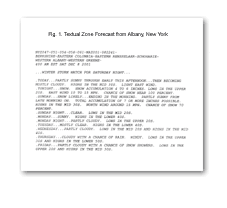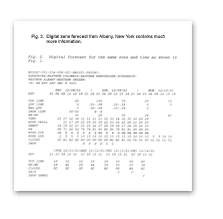
What is the NDFD?
NWS provides access to gridded forecasts of sensible weather elements (e.g., cloud cover, maximum temperature) through the National Digital Forecast Database (NDFD). NDFD contains a seamless mosaic of digital forecasts from NWS field offices working in collaboration
with the National Centers for Environmental Prediction (NCEP). The database is made available to all customers and partners from the public, private and
academic sectors. Those customers and partners may use this data to create a wide range of text, graphic, gridded and image products of their own. Over
time, NWS will offer a wider array of gridded forecast elements and a larger set of graphical presentations. See our Development page for details
of what new grids, products, and capabilities of the NDFD are coming on line.
The Operations Concept for the NWS Digital Services describes the transition the NWS is making as we implement the
NDFD and presents our strategies for provision of digital services to meet the evolving needs of our customers and partners.
Experimental Image of NDFD Data, Maximum Temperature Map

Why Create an NDFD?
Many technological advances and scientific breakthroughs have allowed NWS weather forecasts and warnings to become much more specific and accurate. However, the production and dissemination of routine NWS forecasts must keep pace with the need for such information in this digital age. A primary means of providing sensible weather element forecasts (e.g., cloud cover, maximum temperature) from NWS Weather Forecast Offices (WFO) is still in text format.
A new Interactive Forecast Preparation System (IFPS) is being implemented in NWS which provides not only for preparation of familiar text and voiced products, but also creates in digital (i.e., numerical) form the data from which these products are prepared. These digital forecasts are put into the NDFD. In essence, the forecaster now enters the forecast variables in digital form instead of redundantly typing several products containing largely the same information. But the real power of a digital database is that it opens the door for providing much more forecast information and in more useful forms. The NDFD will contain much more data than the NWS was previously able to provide, at time scales as small as hourly and space scales of a few kilometers.
For instance, instead of the text-based zone forecast shown in Fig. 1, a digital forecast for the same area is shown in Fig. 2. While each of these forecasts has its use today, and both were produced from the local digital database at WFO Albany, New York, the product in Fig. 2 contains much more information.
 Fig. 1. Text-based Zone Forecast from Albany, NY Fig. 1. Text-based Zone Forecast from Albany, NY |
 Fig. 2. Digital Zone Forecast from Albany, NY Fig. 2. Digital Zone Forecast from Albany, NY |
 |
 |
How is the NDFD Created?
The creation of NDFD starts with the formulation of digital forecasts at each WFO. What does it mean to "make digital forecasts?" All information in a digital computer is digital. But it is no small task to enter the large number of values needed to represent forecast conditions at the needed space and time scales for even some relatively small area such as a county-sized zone from the present out to a few days. Further, a WFO is responsible for making forecasts for areas much larger than a single county. IFPS has been developed for this purpose.
Using IFPS, the WFO digital forecasts are updated as the need arises; they become official at a designated "effective" time when entered into the NDFD. It is expected that the NDFD will be updated hourly. This does not mean that all forecasts in the NDFD will be updated hourly, but usually only a small portion affecting limited areas and/or periods.
The digital database makes the updating of forecasts easier. For minor or only moderate changes, the forecaster at a WFO can change a few numbers or grids, and a whole suite of text, voiced, and graphic products can be generated automatically. However, sometimes numerical model results will make wholesale changes necessary.
What's in the NDFD?
For each weather element and each time projection, the individual grids from the WFOs are entered into the NDFD. The grids sent by the WFOs do not overlap each other except for a narrow boundary. The NDFD always contains a current set of forecasts, as provided by the WFOs. Time and spatial resolution varies by weather element and projection as appropriate for user needs, forecast skill, and forecaster work load. The national grids are mosaics of these individual grids. It is a challenge to insure the mosaiced grids are "seamless" at the boundaries between WFO areas. Discontinuities are much more apparent when fine scale grids are abutted than with the current set of NWS products. Thus, collaboration among National Centers and WFOs to ensure consistent forecasts is critical.
The NDFD will also contain watch and warning information and weather elements from NCEP centers such as marine and climate products.
For a more detailed description on NDFD contents, go to NDFD contents.
What are the Benefits of an NDFD?
Benefits of a digital database are extensive. Partners in the production and dissemination of weather forecast products should find the NDFD a gold mine of information. It will be up to date, with the exception of time-critical warnings that are disseminated within seconds by other means, and will be national in scope. It will eventually contain essentially all the basic information from which forecasts are produced by the NWS.
Businesses will be able to produce a plethora of applications and products, either general information for radio and television broadcast, or tailored products for specific customers. For example:
- decision support systems that fit the forecast to the problem
- weather information along a path -- forecasts for a drive across country with projections matched to user itinerary
- text generation in more than one language
- forecasts for vehicles and hand-held devices with Global Positioning Systems
- controls for smart appliances (e.g., heating, cooling, irrigation)
- graphics for mass media.
Teaming the NDFD with GIS systems will provide very powerful capabilities. The NDFD will give customers what they want when they need it.

Commercial products available today that provide point forecasts or large scale graphics sometimes rely on direct model output or the algorithmic interpretation of model output (e.g., MOS). The NDFD will be the source of more accurate official NWS forecasts produced by forecasters at WFOs and NCEP; previously such digital forecasts were not available.
Any individual user with a computer and access to the internet can download information from the NDFD to suit his or her needs. No longer will this customer have to wait for the timed broadcast of weather information, but can time the receipt of the specific information needed to his or her schedule.
How Accurate Are NDFD Products?
Forecast accuracy is determined by comparison of forecast data to observations. Forecast skill is evaluated by comparison of the forecast data to forecast standards. We are now providing information on the forecast skill and accuracy for the gridded forecasts made available via the NDFD.
Verification of the gridded forecasts in the NDFD is done to compute the forecast accuracy with a comparison to point observations. Surface observations of variables such as temperature, wind speed and precipitation amounts are routinely collected at approximately 1000 sites nationwide. Comparison of these observations to the gridded forecasts in NDFD provides a measure of the forecast quality, or accuracy. Verification Procedures for NDFD and other NWS products are described in the NWS Instruction 10-1601.
AMS Short Course: NWS Goes Digital
At the 2003 Annual Meeting of the American Meteorological Society (AMS), NWS presented a short course titled "NWS Goes Digital." This course presented information on the NDFD and how the data could be used. See our Short Course page to view the presentations given during this course.